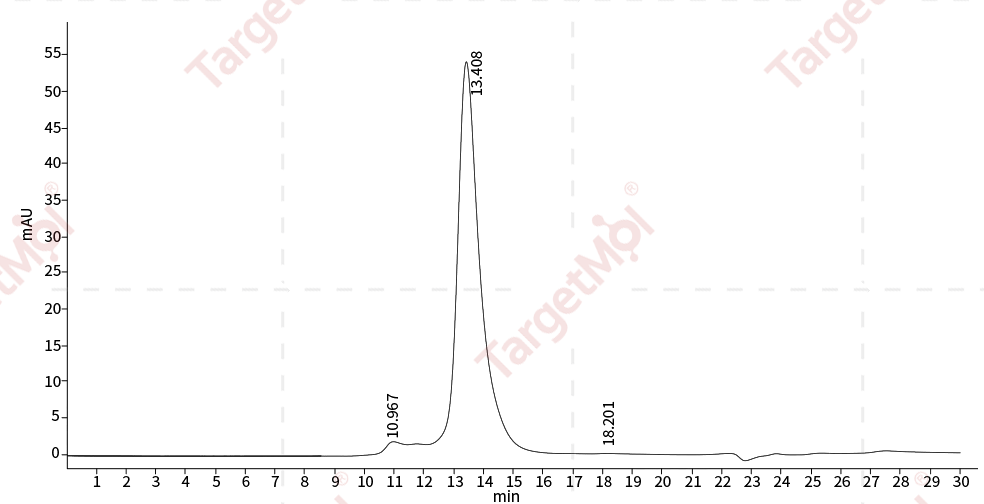Shopping Cart
- Remove All

Your shopping cart is currently empty

| Pack Size | Price | Availability | Quantity |
|---|---|---|---|
| 50 μg | $386 | In Stock | |
| 100 μg | $602 | 7-10 days | |
| 200 μg | $939 | 7-10 days | |
| 500 μg | $1,690 | 7-10 days |
| Biological Information | Measured by its ability to bind mouse AGER-His in functional ELISA. |
| Description | HMGB1 Protein, Mouse, Recombinant (hFc) is expressed in HEK293 mammalian cells with hFc tag. The predicted molecular weight is 53.3 kDa and the accession number is P63158. |
| Species | Mouse |
| Expression System | HEK293 Cells |
| Tag | N-hFc |
| Accession Number | P63158 |
| Synonyms | HMG-1,SBP-1,high mobility group box 1,p30,Hmg1,DEF,amphoterin |
| Construction | The Mouse HMGB1 (P63158) (Met 1-Glu 215) was fused with the Fc region of Human IgG1 at the N-terminus. |
| Protein Purity | > 85 % as determined by SDS-PAGE. ≥ 90 % as determined by SEC-HPLC.  |
| Molecular Weight | 53.3 kDa (predicted) |
| Endotoxin | < 1.0 EU/μg of the protein as determined by the LAL method. |
| Formulation | Lyophilized from a solution filtered through a 0.22 μm filter, containing PBS, pH 7.4. Typically, a mixture containing 5% to 8% trehalose, mannitol, and 0.01% Tween 80 is incorporated as a protective agent before lyophilization. |
| Reconstitution | A Certificate of Analysis (CoA) containing reconstitution instructions is included with the products. Please refer to the CoA for detailed information. |
| Stability & Storage | It is recommended to store recombinant proteins at -20°C to -80°C for future use. Lyophilized powders can be stably stored for over 12 months, while liquid products can be stored for 6-12 months at -80°C. For reconstituted protein solutions, the solution can be stored at -20°C to -80°C for at least 3 months. Please avoid multiple freeze-thaw cycles and store products in aliquots. |
| Shipping | In general, Lyophilized powders are shipping with blue ice. |
| Research Background | High-mobility group box 1 protein (HMGB1), also known as HMG-1 or amphoterin previously, is a member of the HMGB family consisting of three members, HMGB1, HMGB2, and HMGB3. HMGB1 is a DNA-binding nuclear protein, released actively following cytokine stimulation as well as passively during cell death. It is the prototypic damage-associated molecular pattern (DAMP) molecule and has been implicated in several inflammatory disorders. HMGB1 signals via the receptor for advanced glycation end-product (RAGE) and members of the toll-like receptor (TLR) family. The most prominent HMGB1 protein and mRNA expression arthritis are present in pannus regions, where synovial tissue invades articular cartilage and bone. HMGB1 promotes the activity of proteolytic enzymes, and osteoclasts need HMGB1 for functional maturation. As a non-histone nuclear protein, HMGB1 has a dual function. Inside the cell, HMGB1 binds DNA, regulating transcription, and determining chromosomal architecture. Outside the cell, HMGB1 can serve as an alarmin to activate the innate system and mediate a wide range of physiological and pathological responses. Extracellular HMGB1 represents an optimal " necrotic marker" selected by the innate immune system to recognize tissue damage and initiate reparative responses. However, extracellular HMGB1 also acts as a potent pro-inflammatory cytokine that contributes to the pathogenesis of diverse inflammatory and infectious disorders. HMGB1 has been successfully therapeutically targeted in multiple preclinical models of infectious and sterile diseases including arthritis. As shown in studies on patients as well as animal models, HMGB1 can play an important role in the pathogenesis of the rheumatic disease, including rheumatoid arthritis, systemic lupus erythematosus, and polymyositis among others. Besides, enhanced postmyocardial infarction remodeling in type 1 diabetes mellitus was partially mediated by HMGB1 activation. |

Copyright © 2015-2024 TargetMol Chemicals Inc. All Rights Reserved.